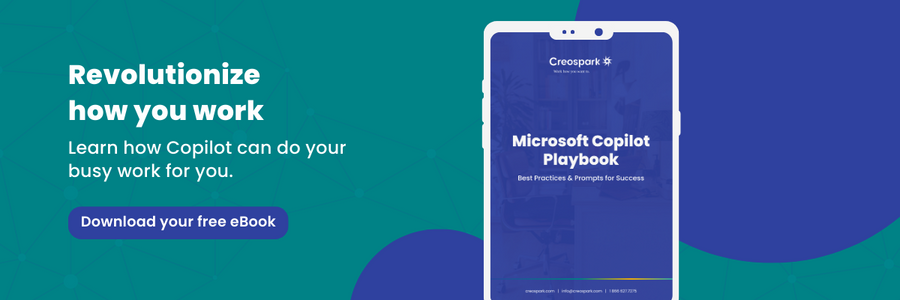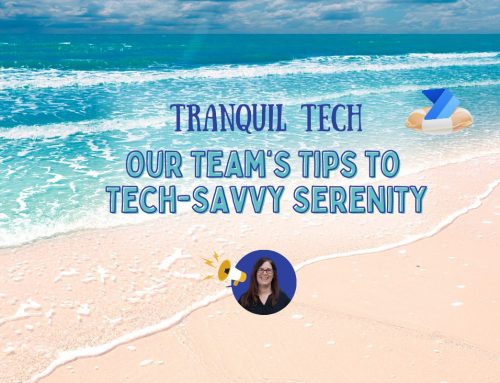Microsoft and ChatGPT | AI Accelerates Productivity in the Workplace
The age of artificial intelligence (AI) is upon us. The technology that once seemed the stuff of Hollywood movies is making its way into reality. While none of us truly know the effect AI will have on society, we’re already experiencing its direct impact on the transformation of Microsoft ecosystems, specifically with ChatGPT, and the way we work. So, without further ado let’s find out how you can use AI to accelerate productivity.
What is AI?
Any program that uses computers and machines to simulate human nature’s decision-making and problem-solving aspects can be considered AI. AI can help people with nearly any task and is useful in every field known to man. Organizations, governments, and individuals are using AI for facial detection, editing texts, developing chatbots, or even creating art.
Microsoft’s been investing in AI and its implementation within the workplace for quite some time. A good example of AI adaptation by Microsoft is Microsoft Syntex. Syntex is a Content AI that uses intelligent document processing to help organizations transform and automate content processes. Syntex was initially integrated into SharePoint to help companies manage their digital assets, and now it’s also available throughout Microsoft 365 and Teams.
The wave of a lifetime
With the huge demand for AI and the public’s justified fascination with this technology, corporate behemoths like Microsoft are looking to catch the first waves and better understand how to leverage this technology to serve their clients better.
In the past three years, Microsoft has invested more than $3 billion in ChatGPT, a natural language processing model introduced by OpenAI in November 2022, and as you’re reading this blog, they’re in talks to invest another $10 billion in this technology and to push its development even further.
ChatGPT is a fascinating AI tool that can write short stories, replicate social media posts, or answer questions. ChatGPT can go as far as creating functional coding solutions for developers stuck on a problem while writing complex essays about philosophy and human nature.
ChatGPT and its capabilities
The foundation of almost everything in the corporate world is language. So, when it comes to a technology capable of generating high-quality written content, the possibilities are endless, and the only limitation is the imagination of its users.
The excellent Excel assistant
There is a rumor on the virtual block that Microsoft is looking for ways to integrate ChatGPT into Microsoft 365 products, including Word, Outlook, and PowerPoint. Even though ChatGPT isn’t fully integrated into Microsoft 365 yet, there are still ways users can leverage this tool to optimize and improve their experience with Microsoft products.
ChatGPT is a fantastic assistant for workers who spend most of their time on Excel worksheets. Using explanations and examples, ChatGPT can assist users in understanding and using Excel formulas and offer shortcuts and hints to help users navigate and utilize Excel more effectively. In addition, ChatGPT can also automate repetitive Excel processes like doing calculations or updating data by developing macros that only call for a single command.
Let’s say you’ve forgotten the formula for taking the average of a set of data. You can ask ChatGPT to “write a formula to give the average of cells C1 to C100,” and it will return “=AVERAGE(C1:100),” which you can just copy and paste into your worksheet. In addition, you can use ChatGPT to write more complex macros to automate repetitive tasks, which would normally be a lot more difficult for users unfamiliar with the coding on Excel.
Content creation
Even though the technology has yet to reach its final form and isn’t fully capable of writing content with a human touch, people expect ChatGPT and AI to transform how we create content. Many marketers believe that AI language processing models aren’t currently capable of generating advertising content because they are too reliant on pre-existing data and cannot generate new ideas.
However, AI is still a great tool for copyrighting and can assist teams with brainstorming, outlines, and more to accelerate content creation. Third parties have already started creating add-ins to bring ChatGPT into Microsoft Word. A fascinating tool like Ghostwriter, developed by Creative Data Studios, now allows users to create content without needing to write a single word. This add-in allows users to brainstorm and create content faster and cheaper than ever before.
Coding made easy
Another great use of ChatGPT is translating natural language into computer codes. This capability accelerates programming for developers and programmers. As they encounter an obstacle, they can refer to the AI for further assistance and quickly find solutions to their coding problems.
However, ChatGPT isn’t the only solution to this problem. In their journey of developing outstanding AI capabilities, Satya and Altman have created an AI program called Codex, specifically designed to help programs with coding. Codex is currently writing 40% of the code for its users, and developers can code 55% faster.
ChatGPT and Power Platform
Users can also leverage ChatGPT to improve their coding in Power Apps and Power Automate. ChatGPT’s ability to translate common language into coding has made it much easier and more efficient for non-coders to leverage the Microsoft Power Platform.
By integrating ChatGPT’s capabilities within Power Automate, Chams S. has created an AI marketing assistant capable of customer service analysis, market trends search, Twitter watch, competitor benchmarking, and summarization of any document. This is just one example of how ChatGPT can enhance the use case of the Power Platforms and automate your business processes.
Microsoft’s future vision for AI
Even though AI is currently integrated into nearly all of Microsoft’s products and is a critical component of its product offerings, Microsoft is still exploring its capabilities to make organizational processes more straightforward and more efficient than ever.
During Satya Nadella’s keynote at Microsoft Ignite 2022, he talked about how Microsoft thinks of AI as the ultimate amplifier and is planning to use it to help organizations “do more with less.” According to Satya, these are just a few examples of how organizations can use AI to become more productive while implementing best practices:
- Microsoft Designer uses AI to create the most visually appealing custom designs based on the given directions and based on your preferences evolves with you. We’re not limited to searching for existing images and will now be able to create images through AI.
- By applying conversational intelligence, salespeople can discover best practices for contacting their leads and improve their strategies.
- Marketing teams can generate “the right content at the right time” instantly.
These are only some of Microsoft’s future visions for implementing AI within the workplace. The opportunities are infinite, and the possibilities are endless, which makes this technology so exciting.
Risks and concerns
There are ongoing concerns regarding AI, many of which are ethical and legal in nature. What risks and concerns do we hear around the workplace?
Misinformation
AI only exists because of its access to data. Most AI tools nowadays, including ChatGPT, operate on regulated databases. However, soon enough, AI will have access to the internet, filled with an unimaginable quantity of false articles and information. Due to its lack of consciousness, AI cannot judge data validity. Therefore, AI experts need help to solve this problem and prevent AI from generating false information.
Inaccurate results
Like misinformation, AI is incapable of understanding the text it generates; therefore, sometimes, the results are highly inaccurate and don’t make sense. Sam Altman, the CEO of OpenAI, has previously tweeted about the current limitations of this technology and said: “We have lots of work to do on robustness and truthfulness” of ChatGPT.
Fake expertise
At its core, every AI is a pattern recognition tool. Think of ChatGPT being exposed to millions of written pieces of content, which allows this technology to predict which words come after another and uses this algorithm to form sentences. A fantastic execution tool in theory; however, if humans entirely rely on AI, eventually, they won’t acquire the skills they would’ve had otherwise and will lose the skills they’ve previously acquired. This could give rise to a workforce incapable of crisis management and thinking outside the box to solve complex problems.
A quick recap
AI is a fascinating tool that is capable of unimaginable things. Microsoft and other technology pioneers are looking for ways to implement AI within the workplace and help organizations become more productive than ever before and “do more with less.” To find out more about AI and ChatGPT make sure to register for our upcoming webinar Microsoft 365 + AI | Tap into AI and slay productivity paranoia!
Related Posts
Subscribe our newsletter
Enter your email to get latest updates.

















